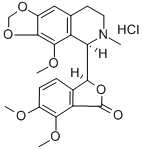CHEMICAL AND PHYSICAL PROPERTIES
| Collision Cross Section | 193.4 Ų [M+H]+ [CCS Type: TW, Method: calibrated with polyalanine and drug standards] |
|---|
SAFETY INFORMATION
| Signal word | Warning |
|---|---|
| Pictogram(s) |
 Exclamation Mark Irritant GHS07 |
| GHS Hazard Statements |
H302:Acute toxicity,oral H336:Specific target organ toxicity,single exposure; Narcotic effects |
COMPUTED DESCRIPTORS
| Molecular Weight | 449.9 g/mol |
|---|---|
| Hydrogen Bond Donor Count | 1 |
| Hydrogen Bond Acceptor Count | 8 |
| Rotatable Bond Count | 4 |
| Exact Mass | 449.1241298 g/mol |
| Monoisotopic Mass | 449.1241298 g/mol |
| Topological Polar Surface Area | 75.7 Ų |
| Heavy Atom Count | 31 |
| Formal Charge | 0 |
| Complexity | 647 |
| Isotope Atom Count | 0 |
| Defined Atom Stereocenter Count | 2 |
| Undefined Atom Stereocenter Count | 0 |
| Defined Bond Stereocenter Count | 0 |
| Undefined Bond Stereocenter Count | 0 |
| Covalently-Bonded Unit Count | 2 |
| Compound Is Canonicalized | Yes |
PRODUCT INTRODUCTION
description
Noscapine Hydrochloride is the orally available hydrochloride salt of the opioid agonist noscapine, a phthalideisoquinoline alkaloid derived from the opium poppy Papaver somniferum, with mild analgesic, antitussive, and potential antineoplastic activities. Noscapine binds to tubulin and alters its conformation, resulting in a disruption of the dynamics of microtubule assembly (by increasing the time that microtubules spend idle in a paused state) and subsequently, the inhibition of mitosis and tumor cell death. Unlike other tubulin inhibitors such as the taxanes and vinca alkaloids, noscapine does not affect microtubule polymerization.

